TPMS CHRYSLER CROSSFIRE 2008 1.G Owners Manual
[x] Cancel search | Manufacturer: CHRYSLER, Model Year: 2008, Model line: CROSSFIRE, Model: CHRYSLER CROSSFIRE 2008 1.GPages: 358, PDF Size: 4.7 MB
Page 132 of 358
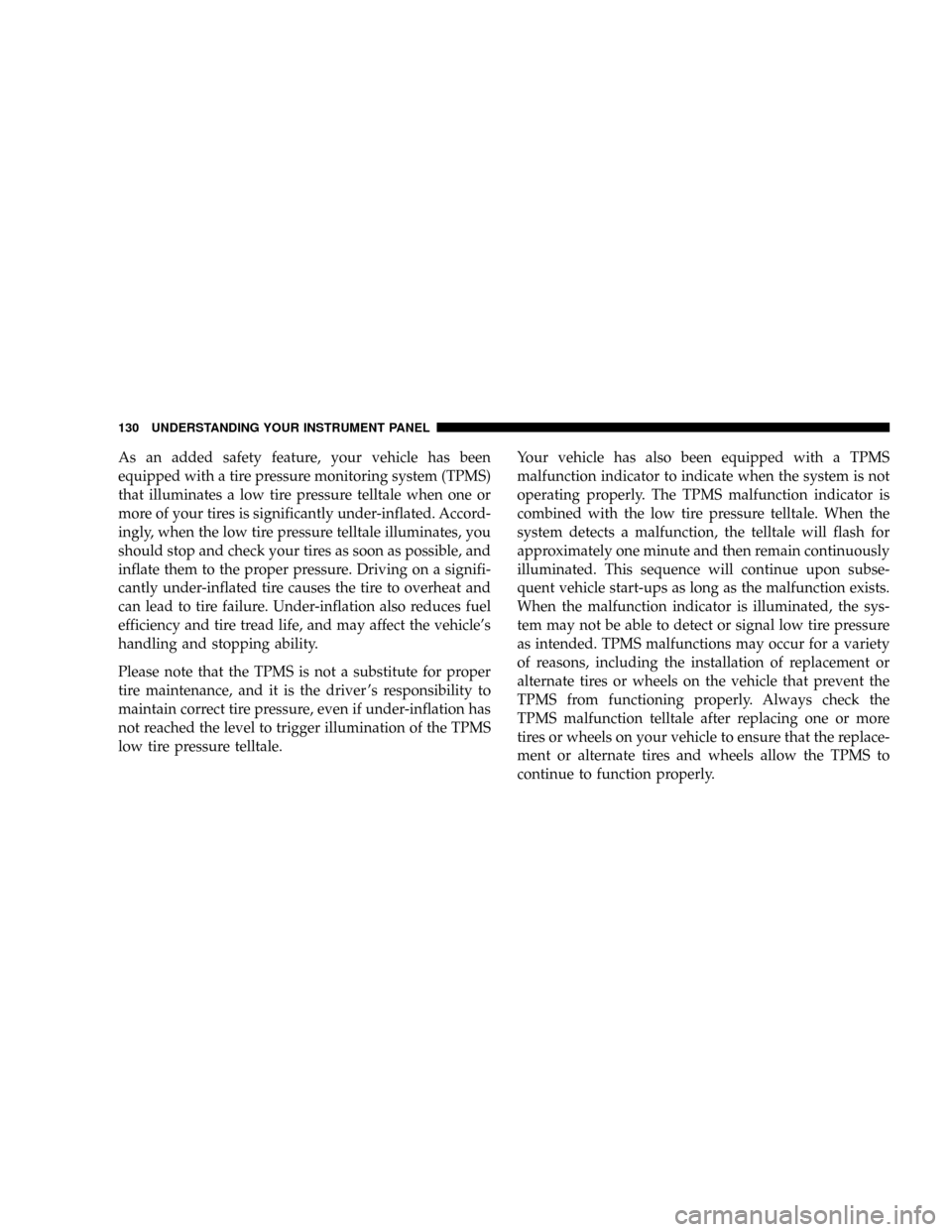
As an added safety feature, your vehicle has been
equipped with a tire pressure monitoring system (TPMS)
that illuminates a low tire pressure telltale when one or
more of your tires is significantly under-inflated. Accord-
ingly, when the low tire pressure telltale illuminates, you
should stop and check your tires as soon as possible, and
inflate them to the proper pressure. Driving on a signifi-
cantly under-inflated tire causes the tire to overheat and
can lead to tire failure. Under-inflation also reduces fuel
efficiency and tire tread life, and may affect the vehicle's
handling and stopping ability.
Please note that the TPMS is not a substitute for proper
tire maintenance, and it is the driver 's responsibility to
maintain correct tire pressure, even if under-inflation has
not reached the level to trigger illumination of the TPMS
low tire pressure telltale.Your vehicle has also been equipped with a TPMS
malfunction indicator to indicate when the system is not
operating properly. The TPMS malfunction indicator is
combined with the low tire pressure telltale. When the
system detects a malfunction, the telltale will flash for
approximately one minute and then remain continuously
illuminated. This sequence will continue upon subse-
quent vehicle start-ups as long as the malfunction exists.
When the malfunction indicator is illuminated, the sys-
tem may not be able to detect or signal low tire pressure
as intended. TPMS malfunctions may occur for a variety
of reasons, including the installation of replacement or
alternate tires or wheels on the vehicle that prevent the
TPMS from functioning properly. Always check the
TPMS malfunction telltale after replacing one or more
tires or wheels on your vehicle to ensure that the replace-
ment or alternate tires and wheels allow the TPMS to
continue to function properly.
130 UNDERSTANDING YOUR INSTRUMENT PANEL
Page 216 of 358
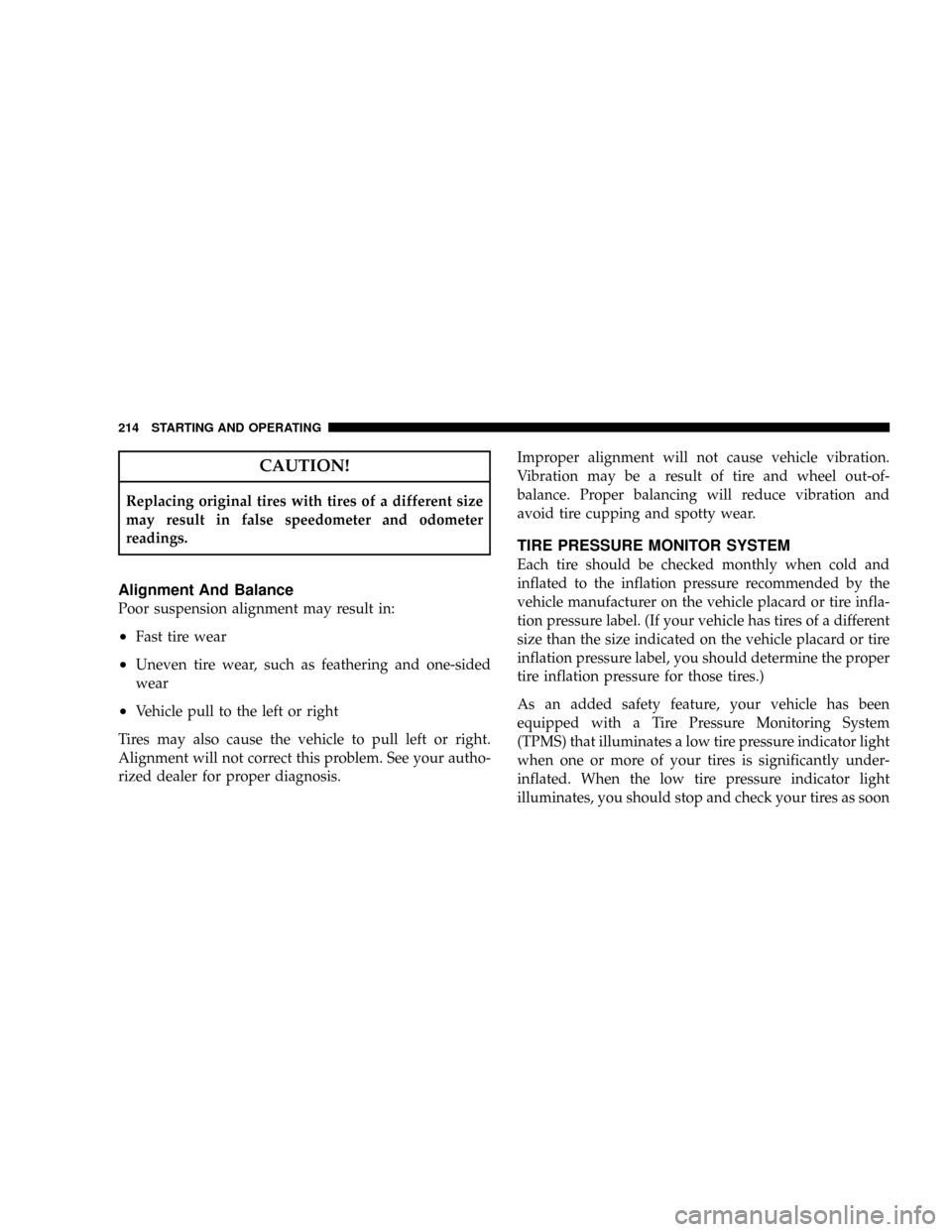
CAUTION!
Replacing original tires with tires of a different size
may result in false speedometer and odometer
readings.
Alignment And Balance
Poor suspension alignment may result in:
²Fast tire wear
²Uneven tire wear, such as feathering and one-sided
wear
²Vehicle pull to the left or right
Tires may also cause the vehicle to pull left or right.
Alignment will not correct this problem. See your autho-
rized dealer for proper diagnosis.Improper alignment will not cause vehicle vibration.
Vibration may be a result of tire and wheel out-of-
balance. Proper balancing will reduce vibration and
avoid tire cupping and spotty wear.
TIRE PRESSURE MONITOR SYSTEM
Each tire should be checked monthly when cold and
inflated to the inflation pressure recommended by the
vehicle manufacturer on the vehicle placard or tire infla-
tion pressure label. (If your vehicle has tires of a different
size than the size indicated on the vehicle placard or tire
inflation pressure label, you should determine the proper
tire inflation pressure for those tires.)
As an added safety feature, your vehicle has been
equipped with a Tire Pressure Monitoring System
(TPMS) that illuminates a low tire pressure indicator light
when one or more of your tires is significantly under-
inflated. When the low tire pressure indicator light
illuminates, you should stop and check your tires as soon
214 STARTING AND OPERATING
Page 217 of 358
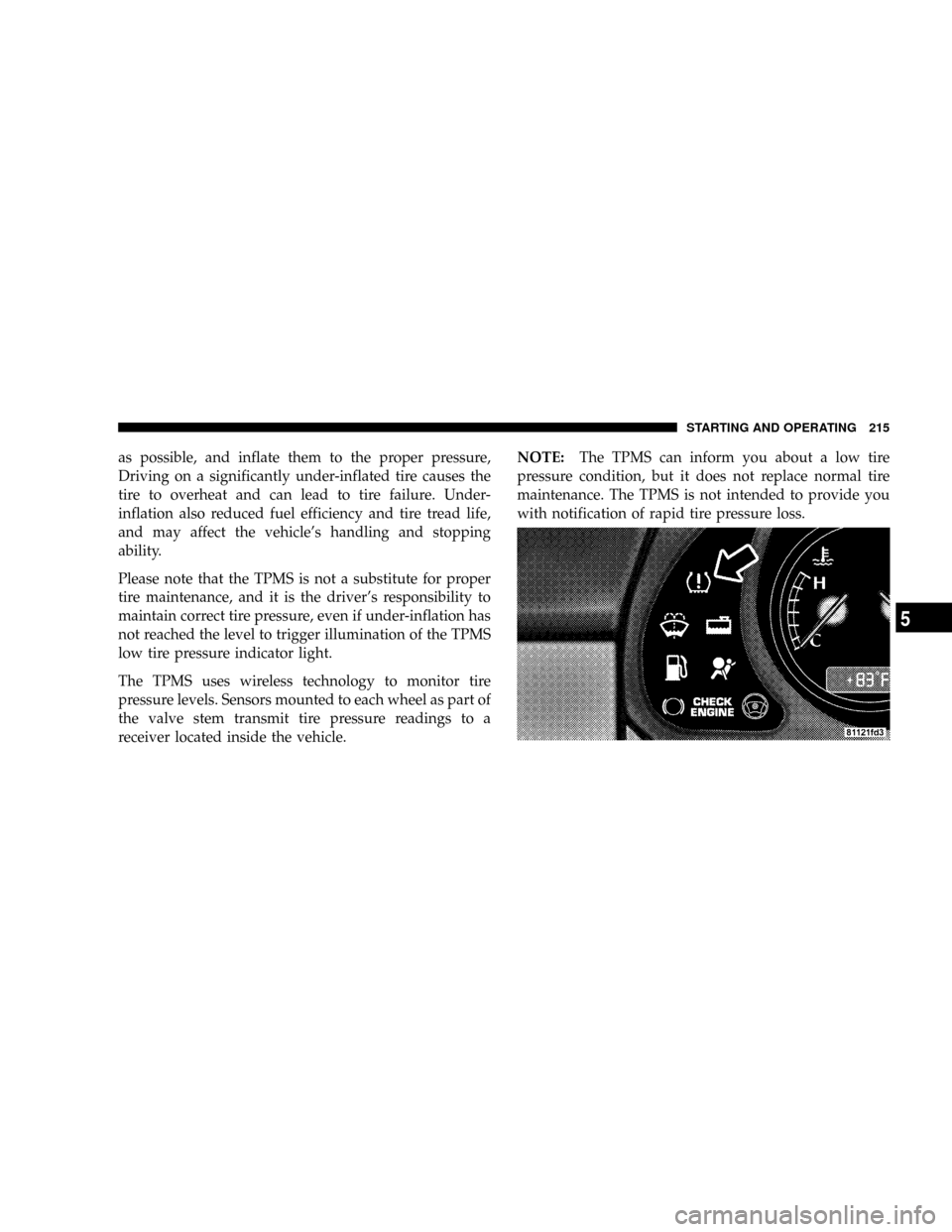
as possible, and inflate them to the proper pressure,
Driving on a significantly under-inflated tire causes the
tire to overheat and can lead to tire failure. Under-
inflation also reduced fuel efficiency and tire tread life,
and may affect the vehicle's handling and stopping
ability.
Please note that the TPMS is not a substitute for proper
tire maintenance, and it is the driver's responsibility to
maintain correct tire pressure, even if under-inflation has
not reached the level to trigger illumination of the TPMS
low tire pressure indicator light.
The TPMS uses wireless technology to monitor tire
pressure levels. Sensors mounted to each wheel as part of
the valve stem transmit tire pressure readings to a
receiver located inside the vehicle.NOTE:The TPMS can inform you about a low tire
pressure condition, but it does not replace normal tire
maintenance. The TPMS is not intended to provide you
with notification of rapid tire pressure loss.
STARTING AND OPERATING 215
5
Page 218 of 358
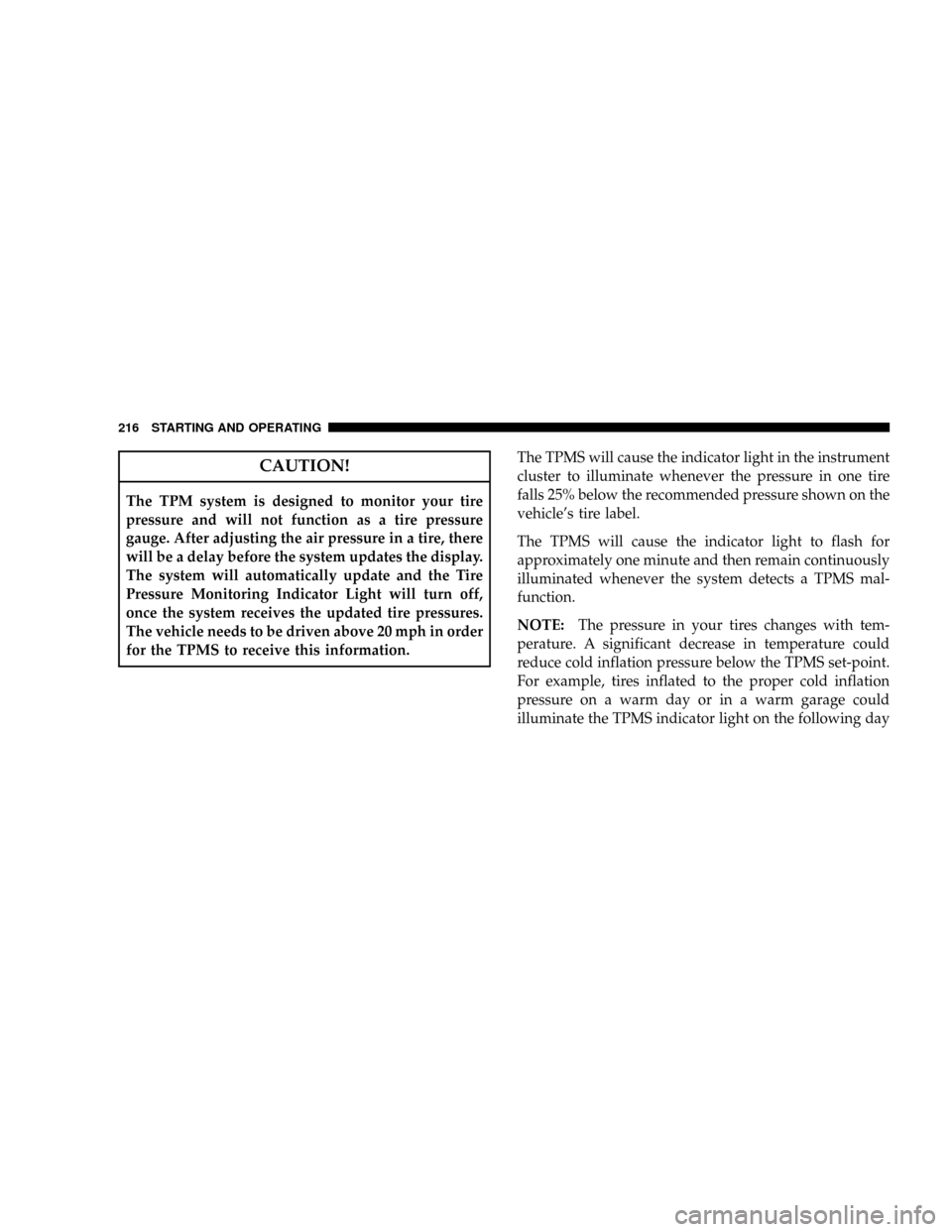
CAUTION!
The TPM system is designed to monitor your tire
pressure and will not function as a tire pressure
gauge. After adjusting the air pressure in a tire, there
will be a delay before the system updates the display.
The system will automatically update and the Tire
Pressure Monitoring Indicator Light will turn off,
once the system receives the updated tire pressures.
The vehicle needs to be driven above 20 mph in order
for the TPMS to receive this information.The TPMS will cause the indicator light in the instrument
cluster to illuminate whenever the pressure in one tire
falls 25% below the recommended pressure shown on the
vehicle's tire label.
The TPMS will cause the indicator light to flash for
approximately one minute and then remain continuously
illuminated whenever the system detects a TPMS mal-
function.
NOTE:The pressure in your tires changes with tem-
perature. A significant decrease in temperature could
reduce cold inflation pressure below the TPMS set-point.
For example, tires inflated to the proper cold inflation
pressure on a warm day or in a warm garage could
illuminate the TPMS indicator light on the following day
216 STARTING AND OPERATING
Page 219 of 358
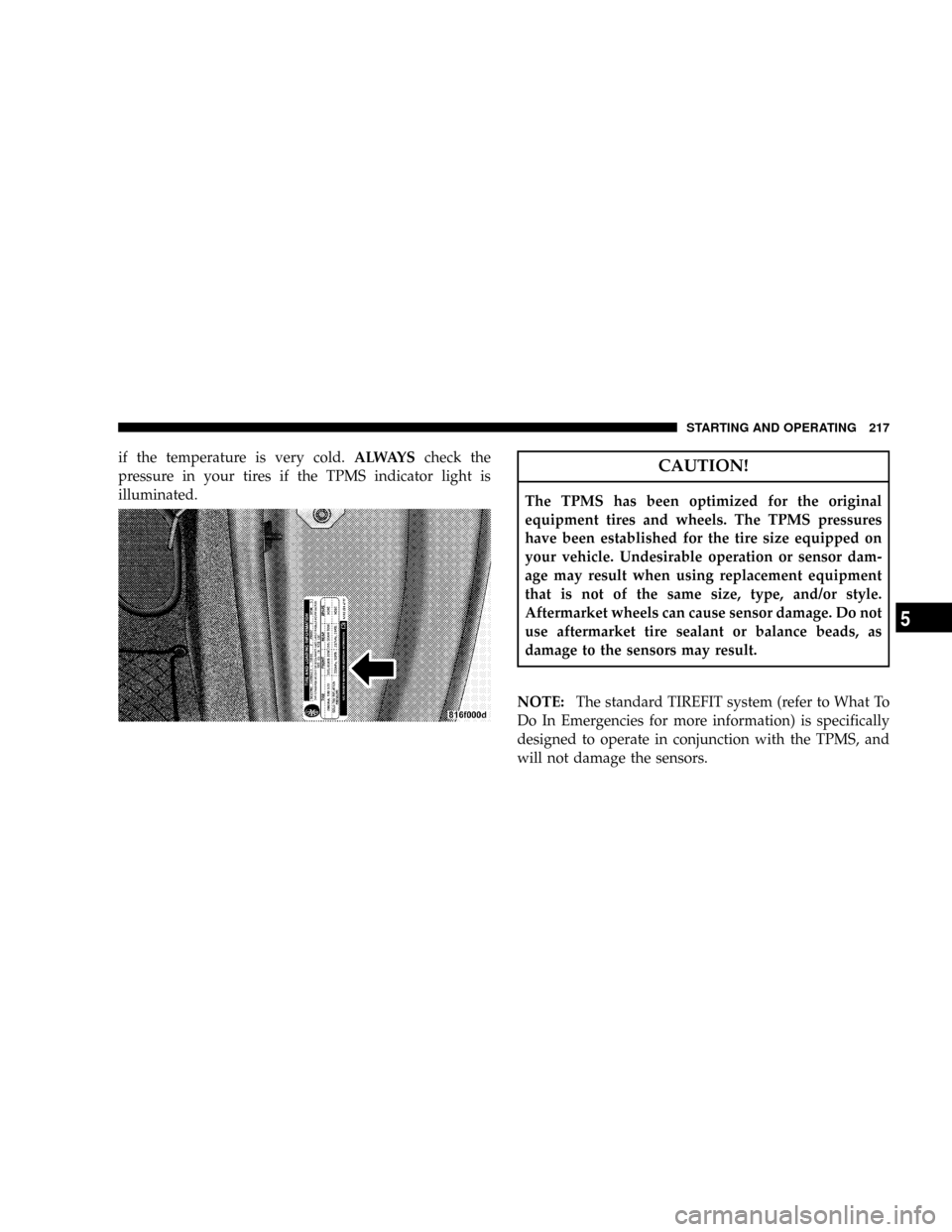
if the temperature is very cold.ALWAYScheck the
pressure in your tires if the TPMS indicator light is
illuminated.CAUTION!
The TPMS has been optimized for the original
equipment tires and wheels. The TPMS pressures
have been established for the tire size equipped on
your vehicle. Undesirable operation or sensor dam-
age may result when using replacement equipment
that is not of the same size, type, and/or style.
Aftermarket wheels can cause sensor damage. Do not
use aftermarket tire sealant or balance beads, as
damage to the sensors may result.
NOTE:The standard TIREFIT system (refer to What To
Do In Emergencies for more information) is specifically
designed to operate in conjunction with the TPMS, and
will not damage the sensors.
STARTING AND OPERATING 217
5
Page 220 of 358
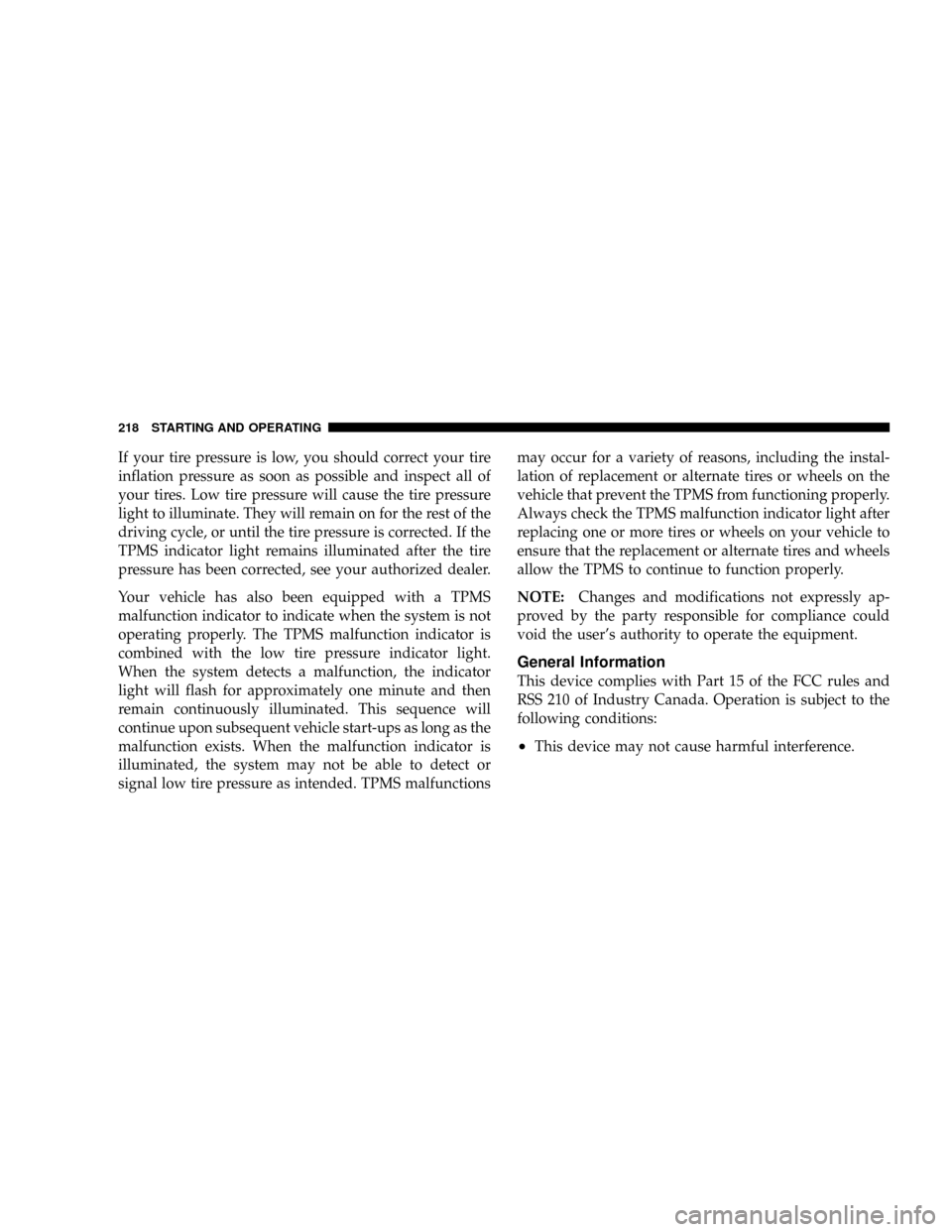
If your tire pressure is low, you should correct your tire
inflation pressure as soon as possible and inspect all of
your tires. Low tire pressure will cause the tire pressure
light to illuminate. They will remain on for the rest of the
driving cycle, or until the tire pressure is corrected. If the
TPMS indicator light remains illuminated after the tire
pressure has been corrected, see your authorized dealer.
Your vehicle has also been equipped with a TPMS
malfunction indicator to indicate when the system is not
operating properly. The TPMS malfunction indicator is
combined with the low tire pressure indicator light.
When the system detects a malfunction, the indicator
light will flash for approximately one minute and then
remain continuously illuminated. This sequence will
continue upon subsequent vehicle start-ups as long as the
malfunction exists. When the malfunction indicator is
illuminated, the system may not be able to detect or
signal low tire pressure as intended. TPMS malfunctionsmay occur for a variety of reasons, including the instal-
lation of replacement or alternate tires or wheels on the
vehicle that prevent the TPMS from functioning properly.
Always check the TPMS malfunction indicator light after
replacing one or more tires or wheels on your vehicle to
ensure that the replacement or alternate tires and wheels
allow the TPMS to continue to function properly.
NOTE:Changes and modifications not expressly ap-
proved by the party responsible for compliance could
void the user's authority to operate the equipment.
General Information
This device complies with Part 15 of the FCC rules and
RSS 210 of Industry Canada. Operation is subject to the
following conditions:
²This device may not cause harmful interference.
218 STARTING AND OPERATING
Page 353 of 358
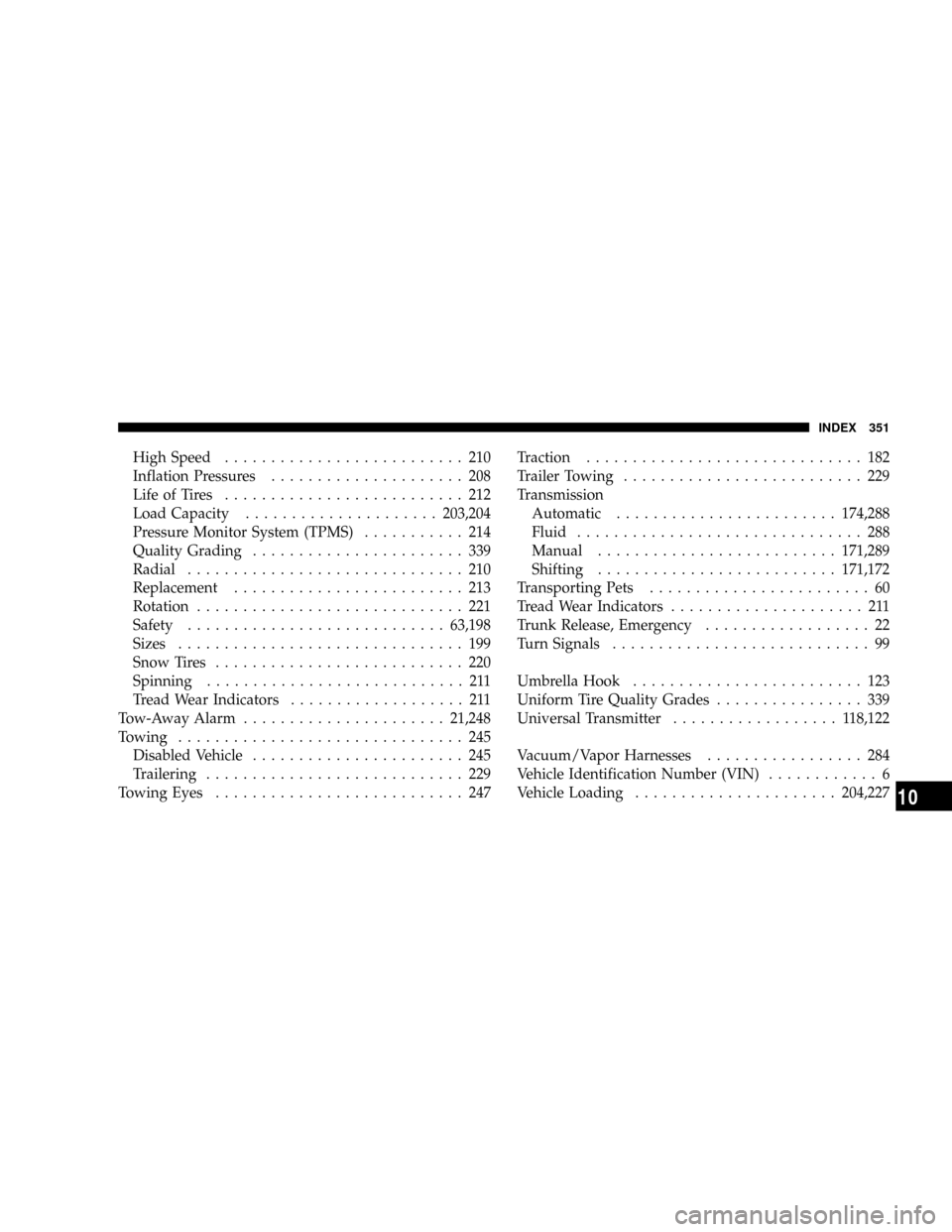
High Speed.......................... 210
Inflation Pressures..................... 208
Life of Tires.......................... 212
Load Capacity.....................203,204
Pressure Monitor System (TPMS)........... 214
Quality Grading....................... 339
Radial.............................. 210
Replacement......................... 213
Rotation............................. 221
Safety............................63,198
Sizes............................... 199
Snow Tires........................... 220
Spinning............................ 211
Tread Wear Indicators................... 211
Tow-Away Alarm......................21,248
Towing............................... 245
Disabled Vehicle....................... 245
Trailering............................ 229
Towing Eyes........................... 247Traction.............................. 182
Trailer Towing.......................... 229
Transmission
Automatic........................174,288
Fluid............................... 288
Manual..........................171,289
Shifting..........................171,172
Transporting Pets........................ 60
Tread Wear Indicators..................... 211
Trunk Release, Emergency.................. 22
Turn Signals............................ 99
Umbrella Hook......................... 123
Uniform Tire Quality Grades................ 339
Universal Transmitter.................. 118,122
Vacuum/Vapor Harnesses................. 284
Vehicle Identification Number (VIN)............ 6
Vehicle Loading......................204,227
INDEX 351
10